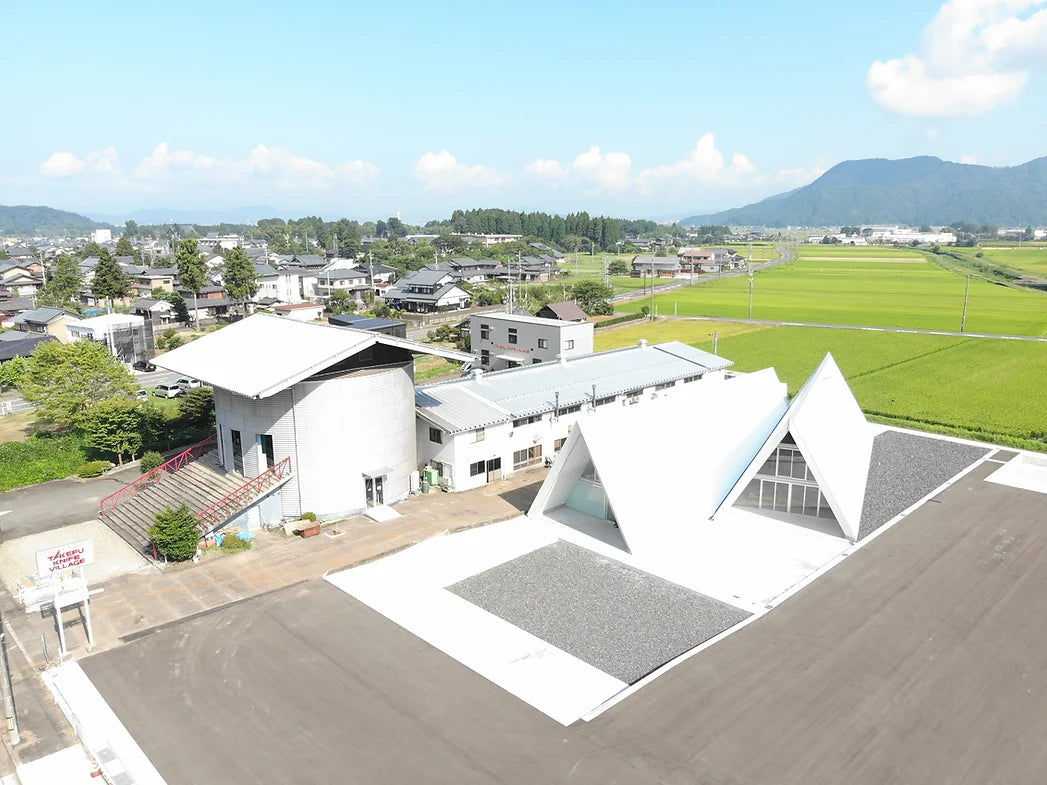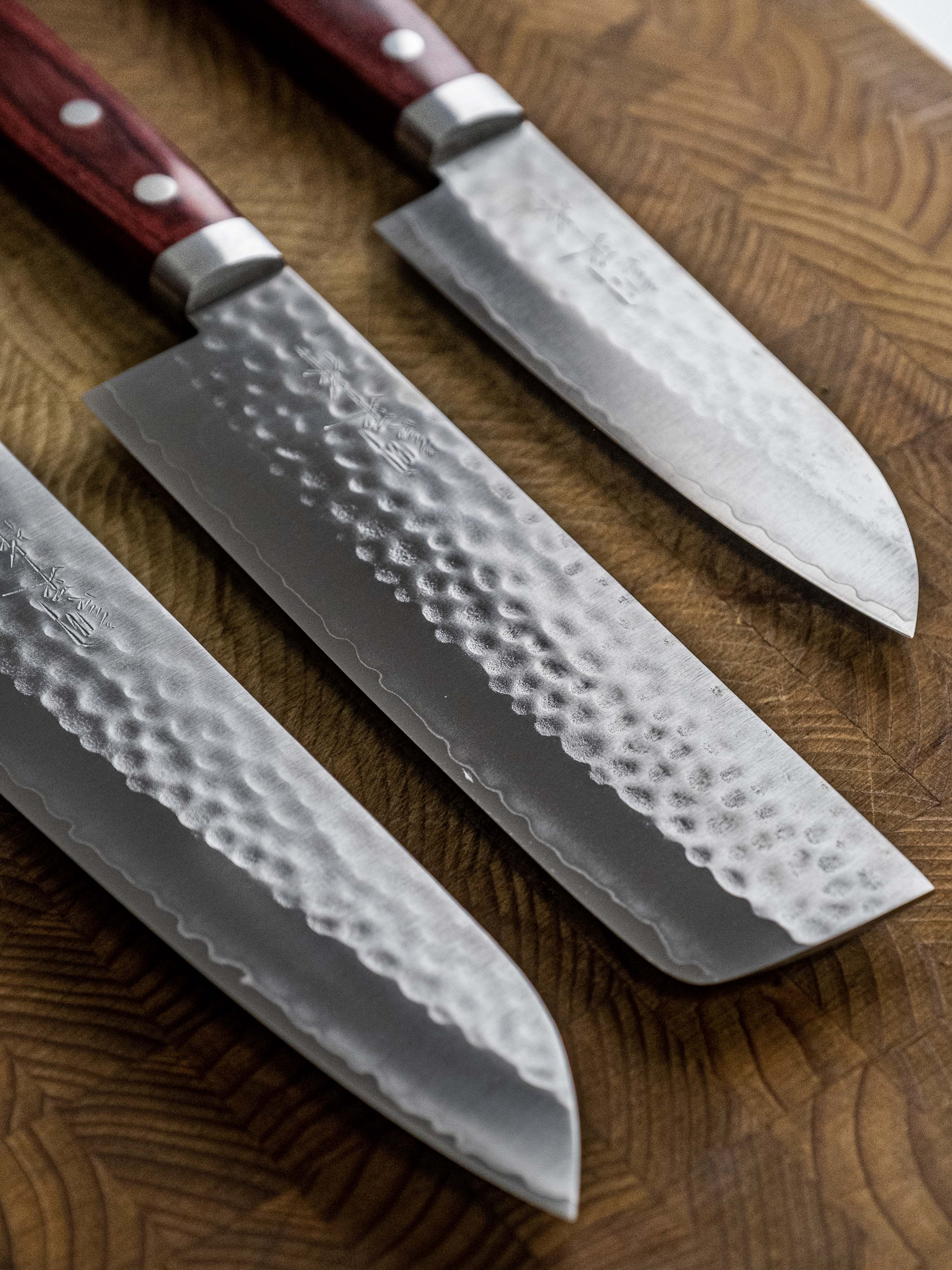Menu

The Takefu Knife Village
All photo credit to the TKV - https://www.takefu-knifevillage.jp/
Sometime around the early 1300's a sword smith by the name of Kuniyasu Chizuru was travelling from Kyoto, searching for a place to work with water suitable for annealing his swords. After finding Takefu suitable, he set up shop and got to work, producing mainly sickles, which would have been a breeze for a master sword smith, due to the large agricultural population and demand in the area. Takefu had quickly become a blacksmithing hotspot in Japan as others set up around him and was known shortly after for its agricultural tools, and it is in historical writtings from the 1600-1800's that Echizen was famous for its production of both sickles and nakiris.
Fast forward to the 1970s, tough times we're coming to an end after WWII and it was in the middle of the the Japanese Economic Miracle that took place between 1945 and 1991. After the war, Japan had lost over 25% of its industrial capacity, and what remained was aging and outdated. While this was a tight spot in Japanese history, the people of the country used this as a time of opportunity to adapt and grow. There was a massive rush of new technology and equipment, and larger industrial facilities were popping up all over the place. While as a whole, this was fantastic for the Japanese economy, large productions of cheaply made, punched out stainless knives flooded the market. While today Japan is synonymous with high quality goods, and balance between technology and tradition, the Economic Miracle was a tough time for smaller artisans to compete with mass produced affordable products.

Many of the blacksmiths in the Echizen region had already funnelled to Takefu earlier on, and were facing a lot of the same issues. Demand was going down, the craftsmen were aging, a shortage of successors and noise complaints in the neighbourhoods they had worked in. A group of smiths got together to discuss the issues that they were facing, and to set up a plan and work together to modernize their businesses and keep up with the times. This group of smiths includes Katsuyasu Kamo, Katsushige Anryu, Hideo Kitaoka, Hiroshi Kato, Haruji Totani, Masanobu Okada, Shiro Kamo, Takeshi Saji, Kazuyoshi Honda, and the late Masami Azai. In 1973 they would form the Takefu Forged Blade Industry Study Society, and would later become the founders of the Takefu Knife Village.

In 1982, the group of smiths were introduced to industrial designer Kazuo Kawasaki, who was a local to the Echizen region. It was alongside him that they had developed a new line of products (seen below) that were imagined by Kazuo and brought to life by the smiths. Between the new products and a rebranding the Takefu Knife Village was born. These knives are still proudly displayed in the new showroom at the TKV, alongside many other products from smiths, current and past, that have worked at the commissary.

Being such a large hit, the smiths were exploding with new lines of knives and products, which had been wildly popular. This new found marriage of tradition and industrial design bridged the gap between the smaller artisan and the larger mass produced products that had been available to the consumer prior. However through all of the time spent together planning and designing the smiths were still largely divided working from their own shops from early in the morning to late in the night, without as much time to collaborate as desired.

It wouldn't be until 1992 that the TKV founding members were ready to take the next step and leave their own small shops behind to build a home base together that would become the TKV that we know and love today. They had recruited Kiko Mozuna, a prominent architect, to design to space for them.

In a total shot in the dark, sink or swim leap of faith, the smiths signed the paperwork and construction on the 300 million yen commissary was underway. Despite Echizen Cutlery being designated a traditional craft in 1982 by the Japanese government, the project was unsubsidized, leaving each of the smiths pooling together their resources for their 30 million yen cut of the bill, leaving little room for error.

Against the odds, the construction wrapped up in 1993 and the TKV was born and the smiths were working together under the same roof. Not only did this give the smiths more room to grow, collaborate and experiment together, but it served as a hub for the craft in the area and attracted many young hopeful smiths. Many of todays most famous smiths and sharpeners have trained at the TKV, some stayed closely involved and made this hub their home like Yu Kurosaki, Yoshimi Kato, Takumi Ikeda and more younger promising smiths like the Kenshiro Hatono, who is scheduled to start his own business next year after learning collectively under the many smiths at the commissary, and some that have come and gone to start their own shops, or return to take over the family business like Shigeki Tanaka did in the late 90's.

So what exactly IS the TKV? Its a lot of things. It's comprised of three main buildings which include the workshop, the retired 1993 hub, and the new 2020 visitors centre/giftshop. While there are other additions to the TKV such as Yu Kurosakis shop right across the street, Yoshimi Kato has his own small shop just across a small stream with a slightly untrustworthy steel bridge, which was not made to accommodate my North American build.

The main shop is a in a warehouse style building with tall ceilings and bursting with large machinery. Set up in a two aisle design as you enter you see an entire wall of spring hammers and forges. When we went for our last visit Ikeda-san and Kamo-san were hard at work forging on back-to-back stations. Ikeda-san was forging out what we think were shaping up to be some shorter gyutos or santokus while Kamo-san was forging out the elusive sobakiri, a massive cleaver with an extended blade that is used exclusively for slicing soba with the addition of a soba board. Widely considered to be one of, if not the most difficult shape to work with, he effortlessly forged out knife after knife with impressive speed and consistency.
To follow the hot forging stations there were 4 cold forging stations, much like a hot station but without the forge and a smaller, lower powered spring hammer. The cold forging process is used to add strength and hardness to the steel, while also hammering out inconsistencies, and get the bulk of the blade straightening out of the way before the knives are passed to the final station on the forging wall, which is a simple stump and hammer directly on the ground that every knife that comes out of this shop has touched. This is the last step of forging and is crucial to make sure the knife is straight, and core steel is aligned before grinding away a bulk of material.

On the opposite side of the shop you'll discover what seems like an endless row of massive sharpening wheels. When we visited last this side of the shop was quite busy and everyone was hard at work grinding knives on various grits of stones, or beating at the stones with an axe to expose fresh abrasive and ensure the stones wear evenly.
In the middle of the shop you'll find many different finishing stations. here you'll see craftsmen working away on smaller wheels cutting the ura into single beveled knives, shaping the profile and spine of knives, polishing blades, and of course the final edge sharpening.

After nearly 30 years of well deserved success and recognition the TKV retired the visitors centre in the 1993 made building and had a new, clean and more modern giftshop/visitors centre built. This new building is home to a beautiful house of mirrors style display with all of the knives designed with Kazuo Kawasaki, glass top counters with many knives of the smiths of the TKV, present and past, and is home to the small shop of Yoshihiro Yauji, a young smith who trained under master Hideo Kitaoka, who makes some very unique thin single beveled knives, in shapes that you traditionally only see double beveled, notably his gyutos.
Originally built out of necessity, the TKV has kept Echizen on the map with a story full of hard work and perseverance. It has served as a hub and community that contributed to the continuation of a traditional Japanese craft through tough times, and is showing no signs of slowing down anytime soon with a massive resurgence of demand for high quality, hand made knives that are truly buy it for life.
- Choosing a selection results in a full page refresh.


